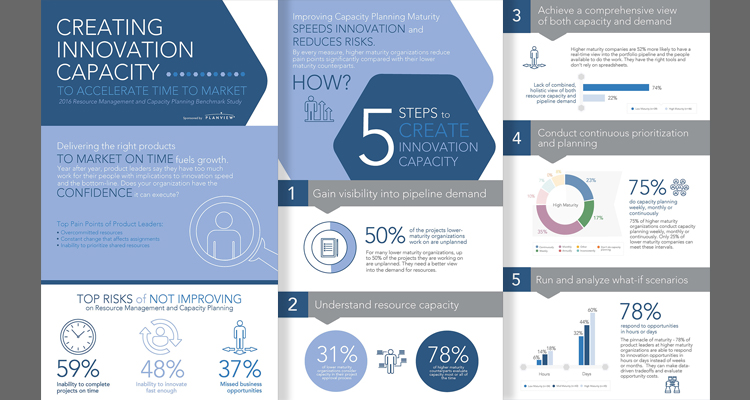
Businesses are under increasing pressure to swiftly innovate, execute digital transformation programs and deliver fast enough to meet growth objectives. Yet this year’s 2016 Resource Management and Capacity Planning Benchmark Study confirms a trend seen in multiple studies over the years in both product development and IT: Organizations continue to overcommit their resources again and again, stifling growth and innovation.
On the bright side, previous studies have also shown that effective capacity planning is a catalyst for enabling organizations to make decisions faster and execute on new opportunities. This year’s research corroborates this and also highlights a breakthrough: Mature organizations, those who regularly assess capacity and demand data, understand the risks of overcommitment and the rewards of addressing it directly. They see it as a potential for differentiation by creating innovation capacity. In other words, the ability to deliver on innovation and digital transformation programs – not just create plans that look good but aren’t achievable in reality.
Key Conclusions from the Research
By every measure, mature organizations are better able to make more informed, faster decisions to optimize their portfolio and resources in support of growth objectives.
- Pain points around capacity planning decrease significantly with maturity.
- Foundationally, mature organizations are 47 percent more likely to have a comprehensive view into both capacity and pipeline demand. They have the ability to evaluate whether to take on new projects and to run strategic what-if scenarios to support decision-making.
- As a result, the vast majority (80 percent) of mature organizations are able to respond to new innovation opportunities and the impact to the portfolio in hours or days instead of weeks or months.
- In addition, higher maturity organizations reduce time-to-market risks by 16 percent.
This means that these companies are not saying “yes” to every innovation initiative or project. They are able to evaluate their options and make capacity centered decisions that give them much greater confidence that talent is focused in the right areas for growth and delivery.
While organizations are much more aware than in previous studies of the importance of considering capacity in their portfolio investment and approval decisions (average of 73 percent), lower maturity organizations still find real-time capacity planning extremely difficult to do without a fire drill for information. In fact, 20 percent of lower maturity companies do not take capacity into account at all before committing to projects or work. The risks of not taking into account the capacity to deliver – or doing it poorly – puts companies at risk of missing time to market or project timelines.
The Bottom Line
Organizations can’t just keep saying yes, leading to overcommitment that can halt their innovation delivery. There needs to be a better process to consider capacity at every stage of the project or product approval process. The highest maturity organizations are deeply committed to this now and are helping their businesses make better decisions and tradeoffs to meet their growth goals. The result is a progression from blind investments and decision fire drills to a finely tuned innovation machine that knows precisely what talent is available, where it is applied and how it can best be tapped to fuel growth objectives.
Benchmark Your Organization: Are You Capacity Centered?
- Product development and IT leaders should benchmark where their organization is on the capacity planning maturity spectrum. For example:
- How effectively and how fast can the organization assess demand with accurate capacity information?
- How many projects are people working on that never went through the project approval process?
- Does the organization have a comprehensive view into both demand and capacity for real-time, what-if scenarios?
- Where does the organization need to be in the next year?
For more information, discover the five steps to optimize resource capacity by reading the executive insight report into the findings of the benchmark study.
Learn more about the benchmark study and methodology.
In addition, we’ve published two guidebooks of the findings and five steps to becoming capacity centered, one for product development leaders and one for IT leaders that are useful to benchmark with your peers:
For the IT perspective of the Benchmark Study, access the Guidebook for IT Leaders.
For the product development perspective of the Benchmark Study, access the Guidebook for Product Leaders.
We would love to hear from you! Let us know what you think or ask a question in the comments.




